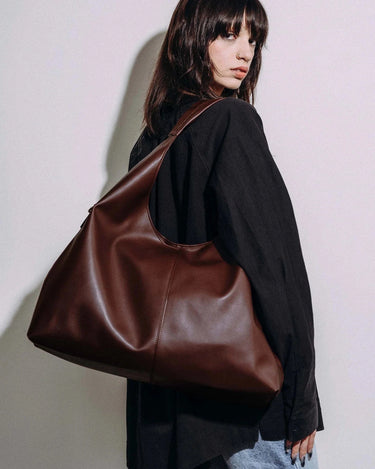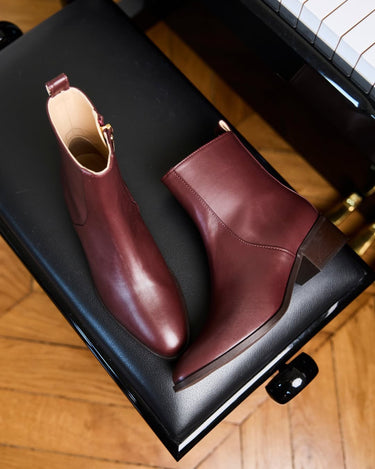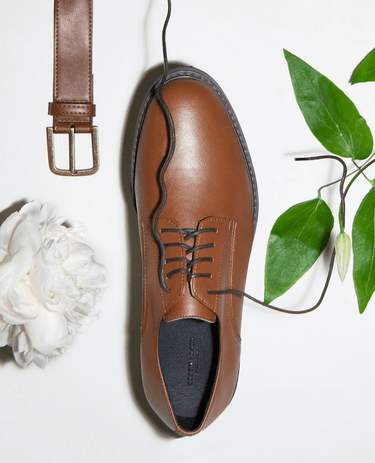Why Vegan Fashion Needs To Also Be Sustainable
When we look at the best and broadest available dataset, it’s clear that animal-derived materials are unsustainable, and that most materials – yes, even synthetics – are less environmentally impactful to produce. However, this doesn’t mean that all animal-free fashion is inherently sustainable. But to truly align with the values of veganism – it should be.
By Emma Hakansson, Journalist & Founding Director of not-for-profit Collective Fashion Justice
The difference between ‘more sustainable’ and ‘genuinely sustainable’
Just because something is ‘more sustainable’, doesn’t make it ‘sustainable’. Let’s use an example: Given the ties to fossil-fuel industries and the shedding of micro-fibres, you might be surprised to know that synthetic materials used to create knitwear, like acrylic and polyester, have a lower cradle-to-gate (basically full production to the point of sale-ready) impact than sheep and alpaca wool. It’s true, as the production of both wool fibres result in major greenhouse gas emissions, as well as eutrophication – not to mention biodiversity loss. What we learn here, is that these synthetic materials are less harmful to produce than wool, but that they are still harmful to the environment. Sustainability exists in a spectrum.
We need to make the most sustainable choices we can, based on what is accessible to us – it’s why choosing synthetic leather over cow skin leather is a more sustainable choice if they’re your two options. But we also need to be slowing down our consumption (which also allows our remaining fashion purchases to be more aligned with our values), and pushing the fashion industry to start using more genuinely sustainable materials.
In the case of leather alternatives, partly bio-based materials like cactus derived Desserto, apple derived AppleSkin or pineapple leaf based Piñatex are increasingly readily available, and have a far reduced footprint, even if they’re not quite perfect either (neither are yet totally biodegradable). The rise of these materials is thanks to public demand and pressure.
The importance of sustainable fashion
Sometimes, it might feel as though trying to find shoes, sweaters, dresses and bags that are vegan can be hard enough – why make it harder by trying to find something that’s more sustainable, too?
Hopefully you're here because you see the importance of sustainable fashion. And sustainability is a critical aspect of veganism. Veganism is about opting out of the oppression of animals, but it’s important that we remember we are all animals – humans and non-humans. When the planet is harmed, we endanger all life on Earth, and that harm is worth avoiding, as far as is practically possible. All life has inherent value.
It’s worth noting too, that more animals than those whose skin, feathers and wool are transformed into clothes are impacted by the fashion industry. Wild, free-living animals are harmed by the fashion industry, especially when land inefficient materials are popular. While we know that animal-derived materials are extremely land inefficient, there are non-animal materials worth being aware of, too. Non-certified rayon and cellulosic materials can be made from trees cut down in old-growth forests, for example. This deforestation is a devastating destruction of habitat for many animals, who are endangered by this loss.
Which animal-free materials are the most sustainable?
Some of the best available materials when considering sustainability and ethics (we call these ‘total ethics materials’) are fortunately also incredibly beautiful, innovative and useful materials. While some are less accessible than others, it’s worth keeping these materials in mind so that you can choose them when possible – and when you can’t, do your best, avoid animal-derived materials, and as much as you can, conventional, virgin synthetics, too.
Total Ethics Leather Alternatives
- Desserto’s cactus leather alternative partly derived from prickly pear cactus.
-
VEGEA grape leather, made from a blend of synthetic and organic waste, repurposed from the wine industry.
-
AppleSkin and other apple leathers made similarly to VEGEA, using apple juice industry waste like apple peels, skins and seeds
- Piñatex, derived from otherwise discarded pineapple leaves.
- Fruit Notterdam’s leather alternative partly made from discarded mango skins.
- Cork, a biodegradable leather alternative stripped from trees without harming them.
- Recycled PU leather, an alternative that makes use of existing synthetic material.
- Washable paper, a choice that, when Forest Stewardship Certified, is sustainable and biodegradable.
- Mirum, a completely plastic-free material that is certified by the USDA’s biopreferred program.
- Treekind, which is home compostable under the right conditions, made from wood waste.
Total Ethics Wool Alternatives
- Sustainably sourced cotton, such as recycled, organic, rain-fed, GOTS certified, myBMP and Good Earth cotton.
- Tencel, a lyocell material made from sustainably sourced wood pulp in a closed-loop system.
- Hemp, a plant-based fibre that is land-efficient, strong and which can grow well without any pesticides.
- Bamboo lyocell, similar to Tencel, but with a different raw material source.
- Post-consumer recycled synthetics, such as those made from ocean waste.
Learn more about these materials here.
Total Ethics Silk Alternatives
- Bamboo lyocell, a versatile material which can offer a slippery, shiny quality like silk.
- Recycled satin, another material making use of existing synthetic materials.
- Cupro, a great alternative to brushed silk which makes use of cotton seed fuzz.
- EcoVero, a sustainably sourced viscose material with a similar silky texture.
- Orange fibre silk, which is harder to come across, but made with a juice industry by-product.

By Emma Hakansson
Emma is an activist, passionate about anti-speciesism and collective liberation more broadly.
She is a writer of both articles and books (How Veganism Can Save Us printed by Hardie Grant will be released mid 2022), a creative director, an ethics consultant, and the founding director of non-for-profit Collective Fashion Justice. Her first short film, Willow and Claude has been selected for international film festivals, and won Best Documentary at Fashion Film Festival Amsterdam. She also runs ethical content production agency Willow Creative Co.
She believes it is never wrong to be kind, and that the prettiest things are kind things. You can read more about her here.
Cover image by Carmona
By Emma Hakansson
Emma is an activist, passionate about anti-speciesism and collective liberation more broadly.
She is a writer of both articles and books (How Veganism Can Save Us printed by Hardie Grant will be released mid 2022), a creative director, an ethics consultant, and the founding director of non-for-profit Collective Fashion Justice. Her first short film, Willow and Claude has been selected for international film festivals, and won Best Documentary at Fashion Film Festival Amsterdam. She also runs ethical content production agency Willow Creative Co.
She believes it is never wrong to be kind, and that the prettiest things are kind things. You can read more about her here.
Cover image by Neu Nomads
Related Articles





















































































































